A total solar eclipse will occur at the Moon's ascending node of orbit on Thursday, April 9, 2043, with a magnitude of 1.0095. A solar eclipse occurs when the Moon passes between Earth and the Sun, thereby totally or partly obscuring the image of the Sun for a viewer on Earth. A total solar eclipse occurs when the Moon's apparent diameter is larger than the Sun's, blocking all direct sunlight, turning day into darkness. Totality occurs in a narrow path across Earth's surface, with the partial solar eclipse visible over a surrounding region thousands of kilometres wide.
It will be unusual in that while it is a total solar eclipse, it is not a central solar eclipse (when the gamma is 0.9972 or larger). A non-central eclipse is one where the center-line of totality does not intersect the surface of the Earth. Instead, the center line passes just above the Earth's surface. This rare type occurs when totality is only visible at sunset or sunrise in a polar region.
Visibility
It will be seen fully from Russia's Kamchatka Peninsula, Magadan Oblast and on the north-east of Yakutia (in the morning on April 10 local time). It will be visible partially throughout northeastern Russia, in Canada, Greenland, Svalbard and Iceland. It will be also partially visible from the western part United States including Alaska, Hawaii, and the North Pacific.
Settlements of total phase: Evensk, Omsukchan, Palana, Seymchan and Zyryanka.
Images
Related eclipses
Eclipses of 2043
- A total lunar eclipse on March 25, 2043.
- A total solar eclipse on April 9, 2043.
- A total lunar eclipse on September 19, 2043.
- An annular solar eclipse on October 3, 2043.
Metonic
- Preceded by: Solar eclipse of June 21, 2039
- Followed by: Solar eclipse of January 26, 2047
Tzolkinex
- Preceded by: Solar eclipse of February 27, 2036
- Followed by: Solar eclipse of May 20, 2050
Half-Saros
- Preceded by: Lunar eclipse of April 4, 2034
- Followed by: Lunar eclipse of April 14, 2052
Tritos
- Preceded by: Solar eclipse of May 9, 2032
- Followed by: Solar eclipse of March 9, 2054
Solar Saros 149
- Preceded by: Solar eclipse of March 29, 2025
- Followed by: Solar eclipse of April 20, 2061
Inex
- Preceded by: Solar eclipse of April 29, 2014
- Followed by: Solar eclipse of March 19, 2072
Triad
- Preceded by: Solar eclipse of June 8, 1956
- Followed by: Solar eclipse of February 8, 2130
Solar eclipses of 2040–2043
This eclipse is a member of a semester series. An eclipse in a semester series of solar eclipses repeats approximately every 177 days and 4 hours (a semester) at alternating nodes of the Moon's orbit.[1]
| Solar eclipse series sets from 2040 to 2043 | ||||
|---|---|---|---|---|
| Ascending node | Descending node | |||
| 119 | May 11, 2040 Partial |
124 | November 4, 2040 Annular | |
| 129 | April 30, 2041 Total |
134 | October 25, 2041 Annular | |
| 139 | April 20, 2042 Total |
144 | October 14, 2042 Annular | |
| 149 | April 9, 2043 Total (non-central) |
154 | October 3, 2043 Annular (non-central) | |
Saros 149
This eclipse is a part of Saros series 149, repeating every 18 years, 11 days, and containing 71 events. The series started with a partial solar eclipse on August 21, 1664. It contains total eclipses from April 9, 2043 through October 2, 2331; hybrid eclipses from October 13, 2349 through November 3, 2385; and annular eclipses from November 15, 2403 through July 13, 2800. The series ends at member 71 as a partial eclipse on September 28, 2926. Its eclipses are tabulated in three columns; every third eclipse in the same column is one exeligmos apart, so they all cast shadows over approximately the same parts of the Earth.
The longest duration of totality will be produced by member 31 at 4 minutes, 10 seconds on July 17, 2205, and the longest duration of annularity will be produced by member 62 at 5 minutes, 6 seconds on June 21, 2764. All eclipses in this series occur at the Moon’s ascending node of orbit.[2]
| Series members 9–30 occur between 1801 and 2200: | ||
|---|---|---|
| 9 | 10 | 11 |
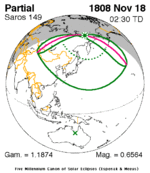 November 18, 1808 |
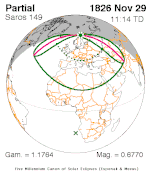 November 29, 1826 |
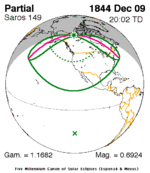 December 9, 1844 |
| 12 | 13 | 14 |
 December 21, 1862 |
 December 31, 1880 |
 January 11, 1899 |
| 15 | 16 | 17 |
 January 23, 1917 |
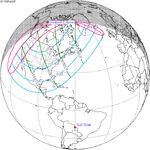 February 3, 1935 |
 February 14, 1953 |
| 18 | 19 | 20 |
 February 25, 1971 |
 March 7, 1989 |
 March 19, 2007 |
| 21 | 22 | 23 |
 March 29, 2025 |
 April 9, 2043 |
 April 20, 2061 |
| 24 | 25 | 26 |
 May 1, 2079 |
 May 11, 2097 |
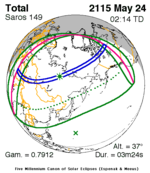 May 24, 2115 |
| 27 | 28 | 29 |
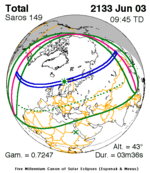 June 3, 2133 |
 June 14, 2151 |
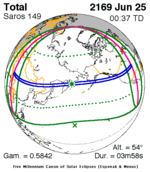 June 25, 2169 |
| 30 | ||
 July 6, 2187 | ||
Metonic series
The metonic series repeats eclipses every 19 years (6939.69 days), lasting about 5 cycles. Eclipses occur in nearly the same calendar date. In addition, the octon subseries repeats 1/5 of that or every 3.8 years (1387.94 days). All eclipses in this table occur at the Moon's ascending node.
| 21 eclipse events between June 21, 1982, and June 21, 2058 | ||||
|---|---|---|---|---|
| June 21 | April 8–9 | January 26 | November 13–14 | September 1–2 |
| 107 | 109 | 111 | 113 | 115 |
| June 21, 1963 | April 9, 1967 | January 26, 1971 | November 14, 1974 | September 2, 1978 |
| 117 | 119 | 121 | 123 | 125 |
 June 21, 1982 |
 April 9, 1986 |
 January 26, 1990 |
 November 13, 1993 |
 September 2, 1997 |
| 127 | 129 | 131 | 133 | 135 |
 June 21, 2001 |
 April 8, 2005 |
 January 26, 2009 |
 November 13, 2012 |
 September 1, 2016 |
| 137 | 139 | 141 | 143 | 145 |
 June 21, 2020 |
 April 8, 2024 |
 January 26, 2028 |
 November 14, 2031 |
 September 2, 2035 |
| 147 | 149 | 151 | 153 | 155 |
 June 21, 2039 |
 April 9, 2043 |
 January 26, 2047 |
 November 14, 2050 |
 September 2, 2054 |
| 157 | ||||
 June 21, 2058 | ||||
References
- ^ van Gent, R.H. "Solar- and Lunar-Eclipse Predictions from Antiquity to the Present". A Catalogue of Eclipse Cycles. Utrecht University. Retrieved 6 October 2018.
- ^ "NASA - Catalog of Solar Eclipses of Saros 149". eclipse.gsfc.nasa.gov.

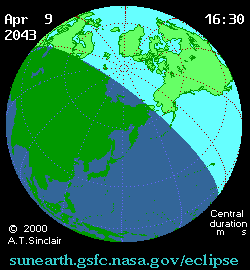




Recent Comments